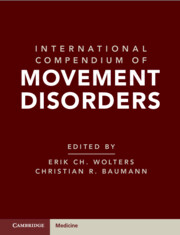Book contents
- International Compendium of Movement Disorders
- International Compendium of Movement Disorders
- Copyright page
- Contents
- Contributors
- International Compendium of Movement Disorders
- Hypo- and Hyperkinetic, Dyscoordinative and Otherwise Inappropriate Motor and Behavioral Movement Disorders
- Section 1: Basic Introduction
- Section 2: Hypokinetic Movement Disorders
- Section 3: Hyperkinetic Movement Disorders
- Section 4: Dyscoordinative and Otherwise Inappropriate Motor Behaviors
- Chapter 46 Ataxia
- Chapter 47 Treatable Hereditary Cerebellar Ataxias
- Chapter 48 Gait and Balance Disorders
- Chapter 49 Episodic/Paroxysmal Movement Disorders
- Chapter 50 Sleep-Related Movement Disorders and Disturbances of Motor Control
- Chapter 51 Drug-Induced Movement Disorders
- Chapter 52 Psychiatric Movement Disorders
- Chapter 53 Functional Movement Disorders
- Section 5: Objectifying Movement Disorders
- Movement Disorders in Vivo: Video Fragments
- Acronyms and Abbreviations
- Index
- References
Chapter 47 - Treatable Hereditary Cerebellar Ataxias
from Section 4: - Dyscoordinative and Otherwise Inappropriate Motor Behaviors
Published online by Cambridge University Press: 07 January 2025
- International Compendium of Movement Disorders
- International Compendium of Movement Disorders
- Copyright page
- Contents
- Contributors
- International Compendium of Movement Disorders
- Hypo- and Hyperkinetic, Dyscoordinative and Otherwise Inappropriate Motor and Behavioral Movement Disorders
- Section 1: Basic Introduction
- Section 2: Hypokinetic Movement Disorders
- Section 3: Hyperkinetic Movement Disorders
- Section 4: Dyscoordinative and Otherwise Inappropriate Motor Behaviors
- Chapter 46 Ataxia
- Chapter 47 Treatable Hereditary Cerebellar Ataxias
- Chapter 48 Gait and Balance Disorders
- Chapter 49 Episodic/Paroxysmal Movement Disorders
- Chapter 50 Sleep-Related Movement Disorders and Disturbances of Motor Control
- Chapter 51 Drug-Induced Movement Disorders
- Chapter 52 Psychiatric Movement Disorders
- Chapter 53 Functional Movement Disorders
- Section 5: Objectifying Movement Disorders
- Movement Disorders in Vivo: Video Fragments
- Acronyms and Abbreviations
- Index
- References
Summary
Hereditary cerebellar ataxia (HA) are a heterogeneous group of disorders characterized by the presence of slowly progressive gait ataxia, dysarthria and other cerebellar signs. Detailed clinical history and neurologic as well as systemic examination are key to accurate diagnosis and hierarchical diagnostic investigations. The initial diagnostic evaluation of patients with HA should include a detailed assessment to rule out acquired treatable etiologies. If such a detailed screening is inconclusive, investigations should be directed towards hereditary causes of cerebellar ataxias. Early diagnosis and treatment can lead to favorable outcomes. Disease-specific therapies have emerged for various cerebellar ataxia syndromes including hereditary ones. Despite these advances, management of the majority of HA remains symptomatic. Moreover, there are no US FDA-approved medications for HAs to date. However, there are a few progressive HA conditions that can improve with disease-specific treatment, particularly if initiated early in the disease course. Here, we discuss various hereditary cerebellar ataxia syndromes that are amenable to disease-specific/targeted treatment.
- Type
- Chapter
- Information
- International Compendium of Movement Disorders , pp. 592 - 599Publisher: Cambridge University PressPrint publication year: 2025

